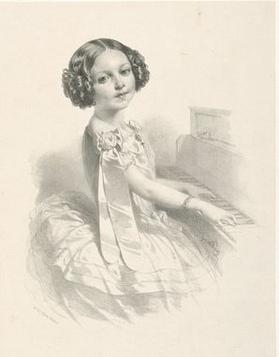Eloísa D'Herbil facts for kids
Quick facts for kids
Eloísa D'Herbil
|
|
|---|---|
 |
|
| Born |
Eloísa María Dolores Juana de la Santísima Trinidad d'Herbil
27 December 1847 Cádiz, Spain
|
| Died | 22 June 1943 (aged 95) Buenos Aires, Argentina
|
| Nationality | Spain, Argentina |
| Other names | Eloísa D'Herbil de Silva, Eloísa D. de Silva, Héloïse d’Herbil |
| Occupation | pianist, composer |
| Years active | 1853–1934 |
| Known for | One of the first women to compose tangos |
Eloísa D'Herbil (born December 27, 1847 – died June 22, 1943) was an amazing Spanish pianist and composer. She was a true child prodigy on the piano. By the time she was just seven years old, she had already performed for kings and queens in England and Spain.
As a child, people called her "Chopin in skirts" because she played the piano so beautifully, just like the famous composer Frédéric Chopin. From a very young age, she also started writing her own music. In 1868, she moved to Argentina. There, she kept writing music and became one of the first women to compose tangos.
Contents
Early Life and Amazing Talent
Eloísa María Dolores Juana de la Santísima Trinidad D'Herbil was born on December 27, 1847, in Cádiz, Spain. Her parents were Raquel Angel de Cadia and Joseph D'Herbil. She started learning piano before her fifth birthday. Her teachers included the American pianist Louis Moreau Gottschalk. She even auditioned for the famous Hungarian composer and pianist Franz Liszt.
Eloísa loved playing music by both Gottschalk and Liszt. Liszt himself praised her incredible ability to play Chopin's pieces. This led critics in Vienna to call the young genius "Chopin in skirts."
Performing for Royalty
By the age of six, Eloísa performed for Queen Isabella II of Spain. The very next year, she played for Queen Victoria and Prince Albert at Windsor Castle in England. In June of that same year, she gave another concert in England. The royal family highly praised her performances. People noticed that her portrait was everywhere, and a sculptor named Luigi Fontana was even making a statue of her.
In 1855, a Spanish poet named Manuel José Quintana wrote a poem praising her talent. This was the last poem he wrote before he passed away. Between 1855 and 1858, Eloísa played concerts every year in London. Important people like the Duchess of Sutherland supported her. She performed in many places, including Buckingham Palace.
She played for Queen Isabella of Spain again in 1857, 1860, and 1862. For her performances, she received beautiful jeweled earrings and a special medallion. Sometimes, she performed with her brother, Antonio or Arturo. They played concerts with piano, harmonium, and violin. By 1865, Eloísa D'Herbil was publishing her own music. Her compositions showed she had amazing talent. In 1867, she was hired to play during the Carnival celebrations in Toledo.
Career in Argentina
Around 1868, Eloísa moved to Argentina. This was likely because of political unrest in Spain at the time. She quickly continued her music career there. In February 1868, she organized a special concert at the Teatro Colón. The money raised helped people affected by cholera.
By 1872, she started using the name Eloísa d'Herbil de Romany for her performances and published music. She performed in Buenos Aires and Montevideo. She had her first child, Federico Román, in Montevideo in December 1872. The family moved back to Buenos Aires by May 1873. She later had two more children, Maria Raquel and José Camilo. After her third child was born, she began using the name Eloisa D. de Silva. Her last child, Maria Eloisa Silva, was born in 1881.
Composing Tangos
Eloísa D. de Silva's first musical pieces were often written for singing or piano. She used lyrics written by other artists. Some of these works include Rayo de luna (Moonbeam) and Los barqueros (The boatmen).
Between 1872 and 1885, she composed some of the very first tangos written by a woman. These included El Maco (The Prison), Y a mí qué (What do I care), Che no calotiés! (Hey, no stealing), and Por la calle Arenales (For Arenales Street). Like other women who wrote tangos, she sometimes used a fake name to protect her reputation. For example, El Maco was published in 1904 under the name Miguel J. Tornquist.
She wrote about 100 tangos, many of them after the year 1900. Some of her other tangos include Calote (Robbery), El mozo rubio (The Blond Boy), Evangélica (Evangelical), La multa (The Fine), Que sí que no (That's Yes That's No), and Yo soy la rubia (I Am the Blond).
Between 1913 and 1914, many of her compositions were listed officially. These included A mi bandera (To my flag), Brumas (Mists), En el baile (In the dance), La Canción del ombú (The Song of the ombu tree), and ¡Ultimo Adiós! (Final Goodbye). In 1934, she composed the Himno del Congreso Eucarístico (Hymn of the Eucharistic Congress). She dedicated this hymn to Cardinal Pacelli, who later became Pope Pius XII.
Later Life and Legacy
Eloísa D. de Silva passed away on June 22, 1943, at her home in Buenos Aires. Her music and her life continue to inspire people. In 2006, Silvia Miguens wrote a novel called La baronesa del tango (The Baroness of the Tango). This book was based on the fascinating life of Eloísa D'Herbil.
See also
 In Spanish: Eloísa D'Herbil para niños
In Spanish: Eloísa D'Herbil para niños

